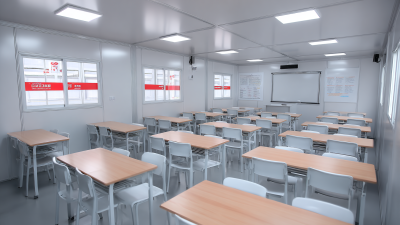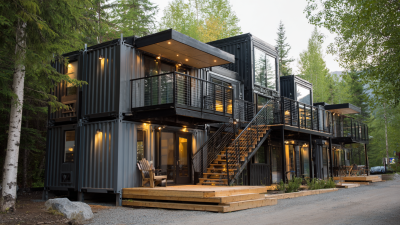The advent of Prefab Classrooms in modern education spaces marks a transformative shift in how educational environments are constructed and utilized. According to a report by the Modular Building Institute, the use of modular education facilities can reduce construction time by up to 50%, enabling schools to respond swiftly to population surges and other pressing needs. Furthermore, a study by the National Institute of Building Sciences indicates that prefab construction can significantly decrease costs by 20-30%, allowing educational institutions to allocate funds to essential resources like technology and instructional materials. As schools strive to create versatile, resilient, and innovative learning environments, Prefab Classrooms emerge as a viable solution that not only addresses immediate spatial demands but also adheres to sustainable construction practices, thereby aligning with the growing emphasis on environmental responsibility. This exploration delves into the myriad benefits of Prefab Classrooms and their potential to revolutionize modern education.

Prefabricated classrooms have emerged as a significant solution in modern education, providing flexibility and adaptability that traditional classrooms often lack. These innovative structures can be quickly assembled and customized to fit the unique needs of educational institutions. One of the standout advantages of prefab classrooms is their ability to create flexible learning environments. They can easily be repurposed for various activities, whether it's collaborative group work, specialized courses, or even informal study areas. This adaptability ensures that educational spaces can evolve alongside changing pedagogical trends.
Tip: When considering prefab classrooms, focus on the layout and design that best supports your educational goals. Open spaces can encourage interaction, while designated quiet areas can aid concentration.
Moreover, prefab classrooms can be equipped with modern technology, further enhancing collaborative and interactive learning experiences. With built-in infrastructure for digital tools, educators can incorporate various teaching methods and engage students in diverse ways. This modern approach not only increases student engagement but also prepares them for a rapidly changing world where flexibility and adaptability are essential skills.
Tip: Invest in modular furniture that can be easily rearranged to suit different teaching styles or group activities. It maximizes the usability of limited space and promotes a dynamic atmosphere.
Prefab classrooms have emerged as a viable solution for enhancing cost efficiency in educational facilities. According to a report by the Modular Building Institute, the use of prefab structures can reduce construction costs by up to 20% compared to traditional building methods. This significant savings is primarily attributed to shorter construction timelines and decreased labor costs. For instance, modular classrooms can be built in as little as 5 to 7 weeks, allowing school districts to allocate funds to other critical areas, such as technology and instructional materials.
Moreover, prefab classrooms offer flexibility in design and usage, which adds to their cost efficiency. The National Council for Education Statistics notes that many schools are facing increasing enrollment numbers but lack the necessary infrastructure to accommodate this growth. Prefab classrooms can be easily scaled and relocated to meet fluctuating demands, minimizing the need for costly expansions or renovations. This adaptability not only aligns with budget constraints but also supports the evolving needs of modern education. Overall, the integration of prefab classrooms into educational facilities is proving to be a strategic financial decision for educational institutions seeking to optimize resources while enhancing learning environments.
| Dimension | Prefab Classrooms | Traditional Classrooms |
|---|---|---|
| Initial Cost | $120,000 | $200,000 |
| Construction Time | 3 months | 12 months |
| Maintenance Cost (Annual) | $5,000 | $10,000 |
| Energy Efficiency Rating | A+ | B |
| Flexibility for Future Needs | High | Low |
| Sustainability Attributes | Recycled Materials Used | Limited Green Materials |
Prefab classrooms offer a unique interplay between technology and sustainability, creating educational spaces that are both functional and environmentally friendly. By leveraging modern manufacturing techniques, these classrooms can be designed with energy-efficient materials and smart technology that promote a greener footprint. Features such as solar panels, green roofs, and high-performance insulation not only reduce energy consumption but also create a healthier learning environment for students.
The integration of technology in prefab classroom design goes beyond energy efficiency. By incorporating advanced learning tools such as interactive boards, integrated Wi-Fi, and modular furniture, these spaces can be easily adapted to suit various teaching methods and curricula. This flexibility ensures that classrooms can evolve alongside educational trends, making them more relevant and effective. Furthermore, the quick assembly and scalability of prefab classrooms mean that schools can address population growth or changes in educational needs promptly, ensuring that every student has access to high-quality learning spaces.
Modular classroom solutions are transforming the educational landscape by fostering enhanced student performance and engagement. These prefabricated classrooms are designed to be flexible and adaptable, allowing educators to create dynamic learning environments that cater to diverse teaching styles and student needs. With an emphasis on modern aesthetics and functionality, prefab classrooms often incorporate natural light, open spaces, and collaborative areas that encourage interaction and participation among students.

Furthermore, the integration of technology within modular classrooms can significantly boost engagement levels. Equipped with the latest digital tools and resources, these classrooms provide students with hands-on learning experiences that promote critical thinking and creativity. As a result, students are more likely to feel invested in their education, leading to improved academic outcomes and a more positive attitude towards learning.
By embracing the benefits of prefab classrooms, schools can create enriched educational environments that not only support academic success but also foster a sense of community and belonging among students.
The trend of utilizing prefabricated classrooms in urban areas continues to grow, driven by the need for rapid, cost-effective educational solutions. According to a report by the Modular Building Institute, the prefab construction industry has expanded by over 20% annually, largely due to its adaptability and efficiency in meeting the needs of modern education spaces. With urban populations rising, schools face the challenge of accommodating more students without the lengthy construction timelines associated with traditional methods. Prefab classrooms can be erected in a fraction of the time, allowing educational institutions to respond swiftly to enrollment increases.
**Tips:** When considering prefab classrooms, look for modular units that are designed with sustainable materials and energy-efficient features. This enhances not only the learning environment but also aligns with eco-friendly initiatives.
In addition to time efficiency, prefab classrooms often provide flexibility in design and layout. According to a study by McGraw Hill Construction, nearly 70% of educators believe that the physical environment directly influences student engagement and learning outcomes. As urban areas continue to evolve, prefab solutions can be tailored to meet the dynamic needs of educational institutions, fostering collaboration and creativity among students.
**Tips:** Engage with local architects who specialize in modular designs to create a space that promotes interaction and aligns with your school's mission.







